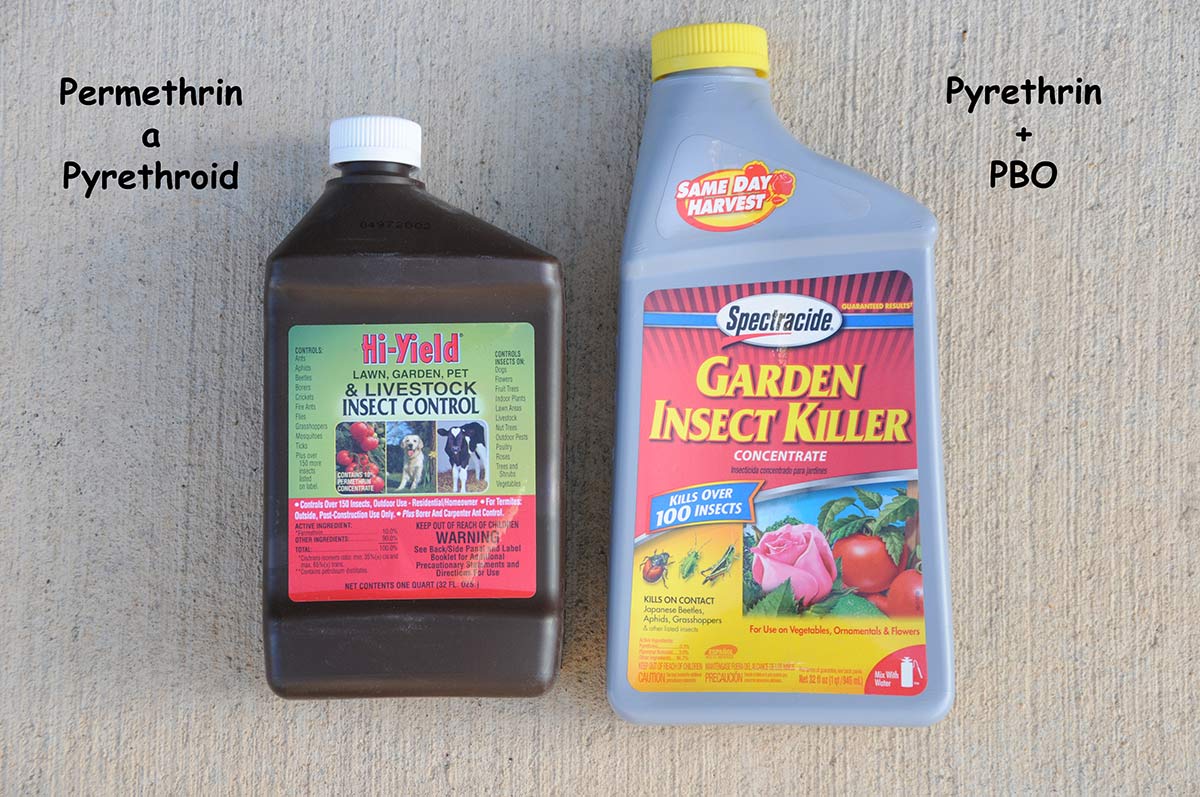Pyrethrins vs Pyrethroids, Vol. 6, No. 29

Confused about the difference between pyrethrins and pyrethroids? Or maybe you never even realized there is a difference? You are not the only one. Every year many gardeners end up buying pyrethrin when what they really want, and need, is a pyrethroid—or vice versa. To clear up the confusion we must first add to it by adding two more “P” words, pyrethrum and permethrin.
Pyrethrum: Pyrethrum is a botanical insecticide extracted from the dried flowers of pyrethrum daisies, Chrysanthemum cinerariifolium. Pyrethrum is one of the first insecticides, with some reports suggesting it has been used for almost 2000 years, and it is still one of the most common organic insecticides used today.
Pyrethrins: Pyrethrins are the actual insecticidal components found in pyrethrum. There are six: pyrethrin I, pyrethrin II, cinerin I, cinerin II, jasmolin I, and jasmolin II. Collectively these active compounds are referred to as pyrethrins, or pyrethrum. Pyrethrins work as contact insecticides on the nervous system of most insects to provide quick knock-down activity. Although they work quickly, pyrethrins also break down quickly and provide little or no residual control. This can be a strength—sometimes you want a product with no residual control, but it is also a major weakness.
The efficacy of pyrethrins can be greatly enhanced by mixing them with a synergist, such as pipronyl butoxide, and synergized pyrethrins are widely used for fast-acting insect control. But because these synertists are not organic, synergized pyrethrins are not allowed for certified organic vegetable production.
Pyrethriods: Science fiction fans know “humanoid” means human-like. Well, pyrethroid means pyrethrin-like. Pyrethroids are man-made insecticides that have been synthesized by copying the chemical structure of natural pyrethrins and making changes or additions at key places in the molecule. Using this approach, chemists have been able to create many synthetic pyrethroid insecticides: permethrin, zeta-cypermethrin, bifenthrin, cyfluthrin, cyhalothrin, and many more. Notice that the chemical names of most pyrethroids end in “thrin,” though there are exceptions. Pyrethroids are effective against a wide range of insect pests; most pyrethroids have relatively low toxicity to mammals, and pyrethroids provide relatively long-lasting residual control. These traits make them ideal insecticides for many home uses, both outdoors and indoors.
Permethrin: Permethrin is just one of many pyrethroid insecticides available today. Permethrin was one of the first pyrethroid insecticides to be marketed and it is still sold under dozens of brand names and in many different formulations. Depending on the formulation and label, permethrin is used for insect control on vegetables, lawns, ornamental plants, or houseplants. Permethrin is especially useful for home vegetable gardens because it can be used on most vegetable crops, controls most major vegetable pests, and has short pre-harvest intervals on most crops. Read labels carefully for exceptions!
Summary: Pyrethrum and pyrethrins are pretty much the same thing. Pyrethrum refers to the crop, the dried flowers, or the product extracted from the flowers. Pyrethrins are the actual active ingredients in pyrethrum. Pyrethroids are synthetic insecticides that were created by copying and modifying the molecular structure of natural pyrethrins and permethrin is just one example of a pyrethroid insecticide. Pyrethroids are much more effective than pyrethrins because they are more toxic to insect pests and provide longer residual control, but only non-synergized natural pyrethrins are suitable for organic vegetable production.
See Bug's Eye View No. 10 of 2016 for more information on pyrethrum daisies.
Blake Layton, Extension Entomology Specialist, Mississippi State University Extension Service.
The information given here is for educational purposes only. Always read and follow current label directions. Specific commercial products are mentioned as examples only and reference to specific products or trade names is made with the understanding that no discrimination is intended to other products that may also be suitable and appropriately labeled.
Mississippi State University is an equal opportunity institution.

